10 Best Native Plants for Los Angeles
BY JUDITH GALLOVA | MARCH 29TH, 2023 | CALIFORNIA, LAWN CARE, LOS ANGELESThere’s a reason one of Los Angeles’ nicknames is City of Flowers and Sunshine: Its Mediterranean climate makes it an ideal location for growing plants. But not every plant is ideal for every climate. If you want an amazing garden, it’s always best to choose native plants that can thrive in the area.
Let’s take a look at 10 of the best native plants for LA.
In this article:
- Why Use Native Plants?
- The 10 Native Plants for Your LA Yard
- How to Choose the Best Natives for Your LA Landscape
- Where to Find Native Plants in Los Angeles
Why Use Native Plants
There are all kinds of reasons to use native plants, the most important being that they are well-adapted to your climate, so they have a greater likelihood of surviving and thriving under the unique conditions in your area. Here is why:
- They’re easier to maintain than non-natives because they grow in the area naturally
- They attract beneficial pollinators and birds to your garden
- They don’t need as many chemical treatments, which damage local ecosystems and water
10 Native Plants for Your Los Angeles Yard
1. Buckwheat (Eriogonum)
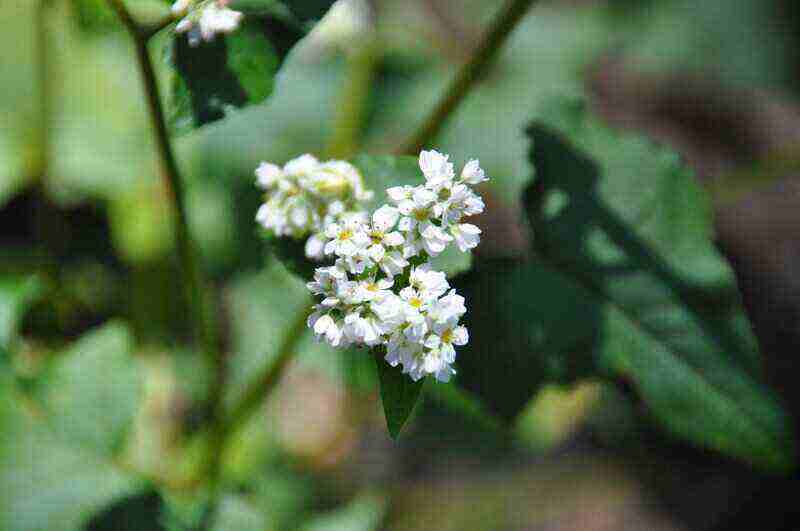
Photo Credit: Chris Samuel / Flickr / CC BY 2.0
Buckwheat plants are not only stunning but also known for being healthy and nutritious. They bloom in late spring, and various beneficial wildlife is attracted to their flowers. You can expect to enjoy them together with birds, bees, and butterflies.
You can pick from eight different types of LA-native buckwheat. For example, California buckwheat is particularly attractive to honey bees. On the other hand, the Bernardino dotted-blue butterfly feasts on ashyleaf buckwheat.
Buckwheat plants have short growing seasons, need little care, and can keep weeds from growing. Some types of buckwheat don’t tolerate cold weather well, so check your area’s hardiness zone and the plant’s hardiness before you buy it.
Growth habbit: Sub-shrub
Mature size: 1 to 6 feet tall
Duration: Annual
Foliage: Evergreen
Sunlight needs: Full sun
Soil preferences: Dry or mostly dry, well-draining soils
Maintenance needs: Cut back every few years to encourage healthy new growth and control shape
Potential hazards: None known (if consumed in moderation)
2. Sage (Salvia)
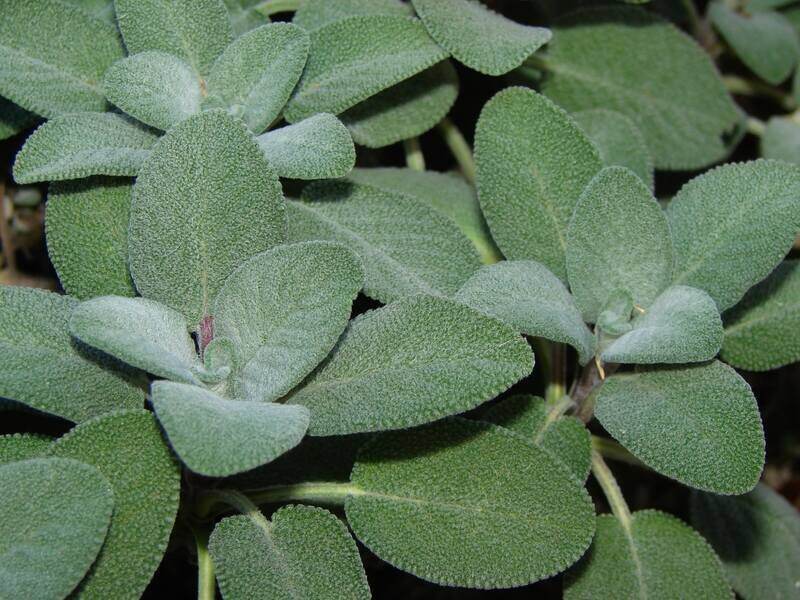
Photo Credit: PublicDomainPictures
Sage comes in various, stunning colors that bloom in the summer. And sage plants are generally seen as non-toxic if consumed in small quantities.
There are 13 species of sage native to Los Angeles, and each plant is unique in its own way. For example, black sage is among the most popular types of sage. Hummingbird sage, on the other hand, attracts hummingbirds and other pollinators and birds with its bright red flowers.
Some types of sage tolerate cold well, and some don’t, so check your area’s hardiness zone and the plant’s hardiness before you buy it.
Growth habit: Shrub
Mature size: 1 to 2 feet tall
Duration: Perennial or annual depending on species and location
Foliage: Varies by type but often deciduous in Los Angeles’ dry climate
Sunlight needs: Full sun, partial shade
Soil preferences: Any well-draining soil
Maintenance needs: Prune lightly in spring; remove dead flowers to encourage more blooms
Potential hazards: Toxic when eaten in high or consistent doses; toxicity levels depend on growing conditions and season
3. California Fuchsia (Epilobium Canum)
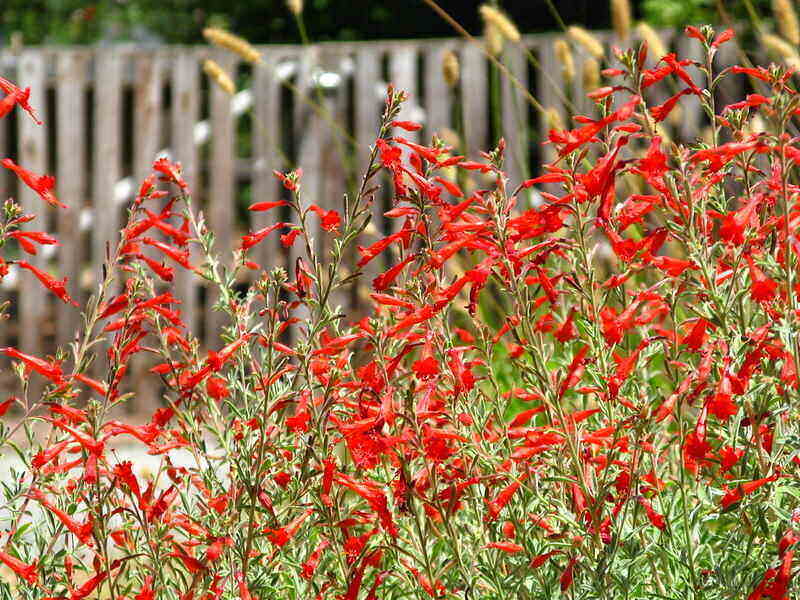
Photo Credit: chuck b. / Flickr / CC BY 2.0
California fuchsia brighten your garden with their vibrant red-orange flowers that bloom in late summer and fall. It’s a low-maintenance plant that thrives in full sun and well-drained soil. California fuchsia is favored by hummingbirds, as well as other pollinators and birds. It’s a great option to bring wildlife into your yard while improving your home’s curb appeal.
Growth habit: Sub-shrub
Mature size: 3 to 18 inches tall
Duration: Perennial
Foliage: Semi-evergreen
Sunlight needs: Full sun
Soil preferences: Any well-draining soil
Maintenance needs: Cut back to the ground after flowering season to promote healthy new growth; water once a month during summer in dry areas
Potential hazards: None known for humans nor most animals
4. California Lilac (Ceanothus)
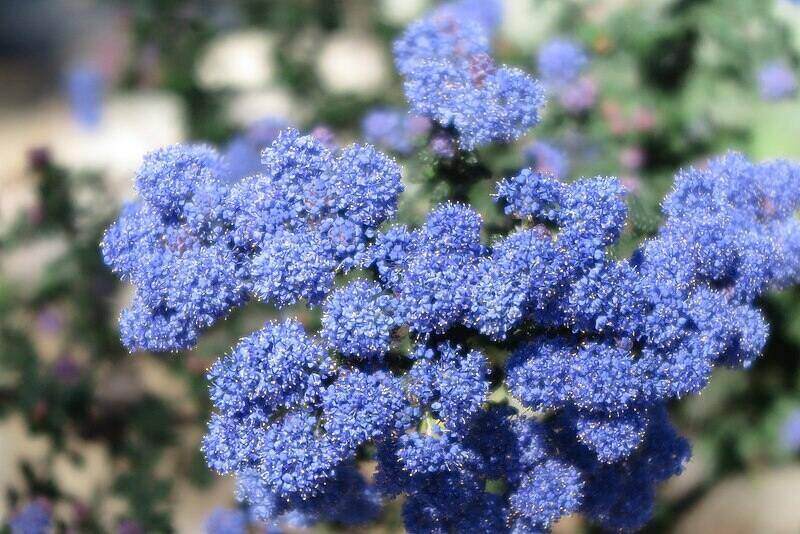
Photo Credit: Changku88 / Wikimedia Commons / CC BY-SA 4.0
California lilac is a beautiful and low-maintenance shrub. It produces vibrant blue, purple, pink, or white flowers in the spring and summer. It’s also drought-tolerant and attracts pollinators, butterflies, and moths. California lilac is suitable for the warmest parts of LA, where temperatures don’t go below 15 degrees Fahrenheit. Check your minimum local temperature here.
There’s a variety of options to choose from. Nine kinds of California lilac are native to Los Angeles, ranging from the rare San Diego ceanothus to the more common buck brush.
Growth habit: Shrub
Mature size: 1 to 6 feet tall
Duration: Perennial
Foliage: Evergreen
Sunlight needs: Full sun, some afternoon shade in hotter areas
Soil preferences: Any well-draining soil
Maintenance needs: Lightly prune and remove dead limbs as needed
Potential hazards: None known
5. Flannel Bush (Fremontodendron Californicum)
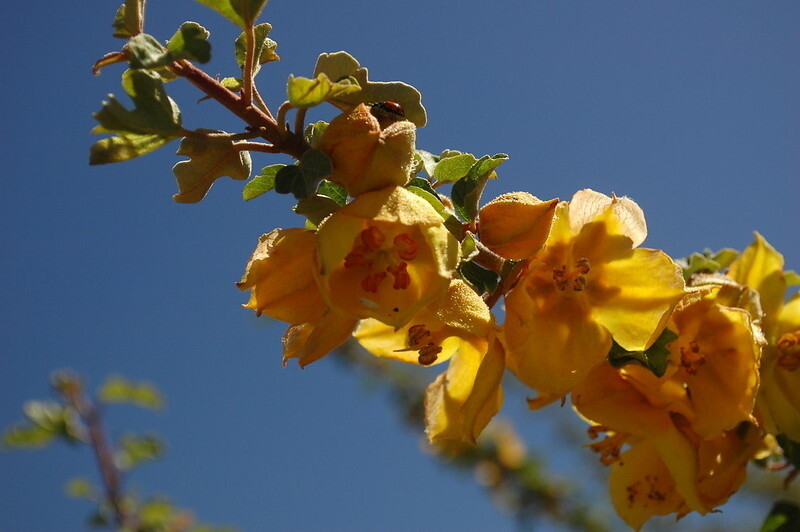
Photo Credit: Jim Staley / Wikimedia Commons / CC BY-SA 2.0
The flowers of the flannel bush plant are large and showy. They bloom in late spring to early summer. Bees and butterflies are attracted to their deep yellow to orange-red blossoms. The plant can grow tall if you take care of it, so it works well for homeowners who want extra privacy.
Take note that the flannel bush is suitable for areas where temperatures don’t go below 20 degrees Fahrenheit. Check your local minimum temperature here.
The plant itself isn’t toxic. However, its stem and leaves can irritate skin and eyes upon contact, so be cautious.
Growth habit: Shrub
Mature size: 6 to 20 feet tall
Duration: Perennial
Foliage: Evergreen
Sunlight needs: Full sun
Soil preferences: Well-draining, sandy soils
Maintenance needs: Avoid summer watering and severe pruning, as these can kill the plant
Potential hazards: Toxic stem and leaves that can irritate skin and eyes
6. Toyon (Heteromeles Arbutifolia)
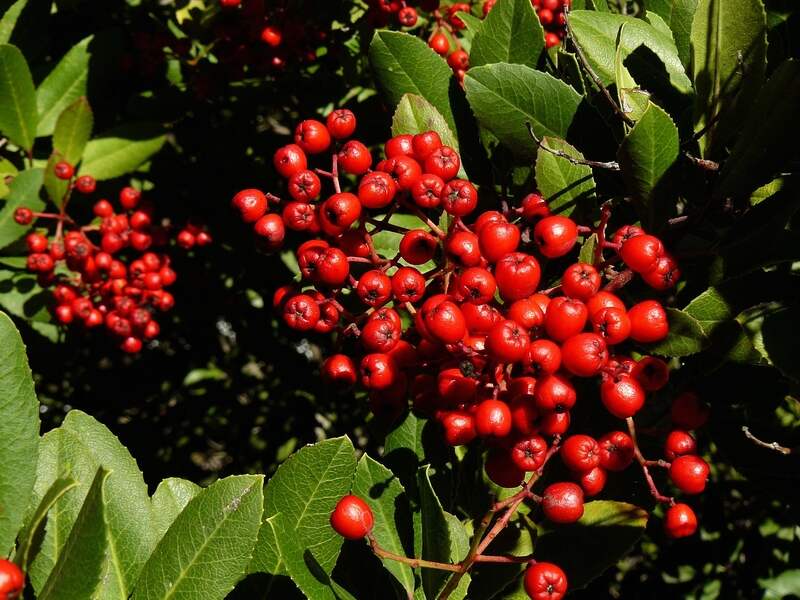
Photo Credit: Pxhere
Toyon, also called the California Holly, can be a shrub or a small tree that grows tall quickly when it receives the right care. It’s superb for attracting local wildlife. The plant has white flowers that bloom in the summer and attract pollinators and birds.
Toyon then produces red berries in the winter. It’s a popular food source for mockingbirds, American robins, and cedar waxwings. Be cautious, though, because they’re toxic to other animals and humans.
Growth habit: Shrub or small tree
Mature size: 6 to 10 feet typically, can reach up to 30 feet
Duration: Perennial
Foliage: Evergreen
Sunlight needs: Full sun, partial shade
Soil preferences: Tolerates most soil types
Maintenance needs: Prune as needed to maintain desired shape and height
Potential hazards: Toxic
7. Common Yarrow (Achillea Millefolium)
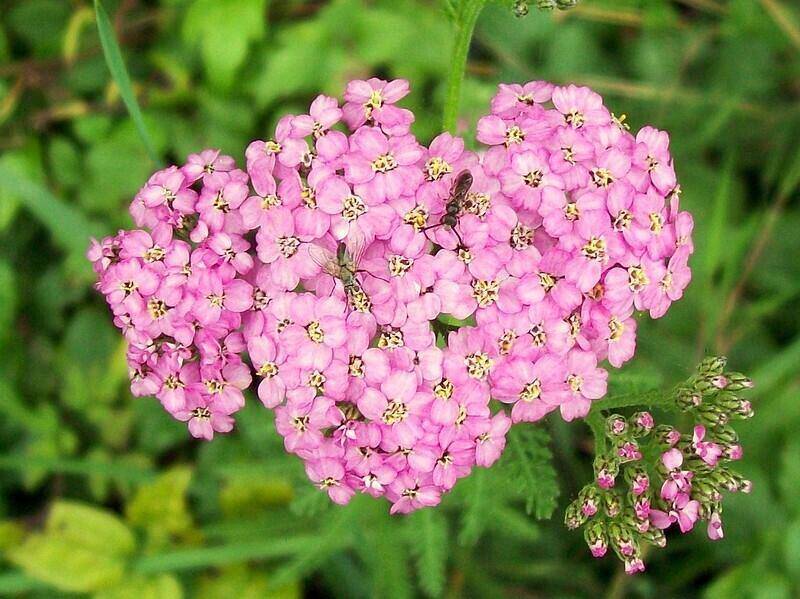
Photo Credit: Peter O’Connor aka anemoneprojectors / Flickr / CC BY-SA 2.0
You’ve almost certainly seen the common yarrow in meadows and along roadsides, with its white, pink, or yellow flower clusters. It is a hardy perennial that can tolerate drought and poor soil conditions. It’s beneficial for birds like starlings, who gather common yarrow for their nests. If you want a charming, easy-care plant that attracts both birds and pollinators, common yarrow may be a great choice.
Take note, though, that the plant is toxic and shouldn’t be ingested. It can also cause irritation if touched.
Growth habit: Flower
Mature size: 1 to 3 feet tall
Duration: Perennial
Foliage: Semi-evergreen
Sunlight needs: Full sun, partial shade, full shade
Soil preferences: Tolerates most soil types
Maintenance needs: Cut off dead flowers to encourage more blooms; treat common problems like aphids, mildew, and stem rot as needed
Potential hazards: Toxic
8. Coastal Prickly Pear (Opuntia Littoralis)

Photo Credit: Nandaro / Wikimedia Commons / CC BY-SA 3.0
The coastal prickly pear is an easy-care, attractive cactus plant. It does well in the warmest parts of LA, where temperatures don’t go below 25 degrees Fahrenheit (check your local minimum temperature here). This cactus has oval branches and bears purplish fruits. Its flowers bloom from spring to summer and support pollinators and birds.
However, keep in mind that the plant and its fruits are prickly and highly toxic for dogs and other animals. Although people like to snack on the plant’s fruit, some of its other parts are mildly toxic for humans, too. There isn’t enough data about the safety of coastal prickly pear fruit or pads, so vulnerable people such as children and pregnant women should avoid eating them.
If you want to know if you can enjoy the fruit of your coastal prickly pear or not, make sure you discuss your diet with a medical professional.
Growth habit: Cactus
Mature size: 1 to 2 feet tall
Duration: Perennial
Foliage: Evergreen
Sunlight needs: Full sun
Soil preferences: Sandy soils
Maintenance needs: Make sure roots don’t get too damp, otherwise they’ll rot.
Potential hazards: Prickly; highly toxic for pets, especially dogs; mildly toxic for humans; not enough data regarding the safety of its fruit or pads
9. Western Blue-Eyed Grass (Sisyrinchium Bellum)
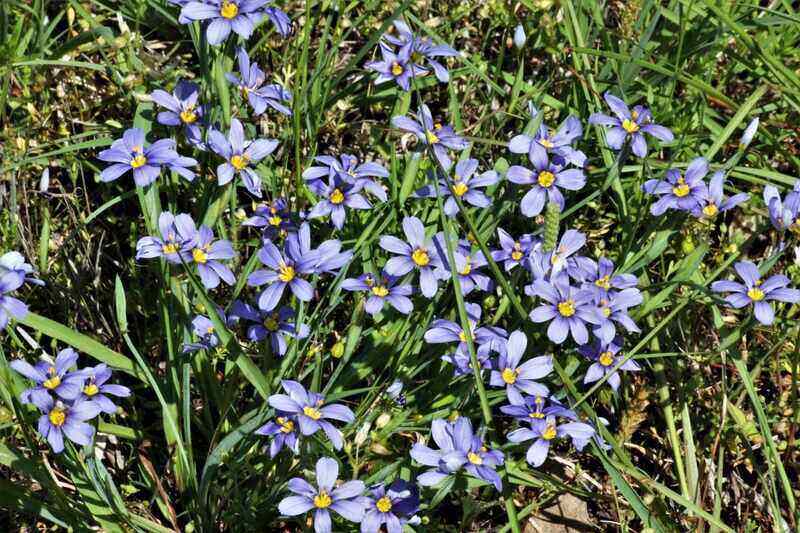
Photo Credit: PublicDomainPictures
Western blue-eyed grass, also called the California blue-eyed grass, has delicate blue flowers. It requires little maintenance and is even considered fire-resistant. Additionally, it attracts pollinators such as bees and butterflies. You can consider planting this flower in your yard for a pop of color and ecological benefits.
Most types of blue-eyed grass aren’t toxic, but there isn’t enough data to determine the effects of western blue-eyed grass. It can also be easily confused for many similar-looking plants which are highly poisonous. Caution is advised.
Growth habit: Flower
Mature size: 1 to 2 feet tall
Duration: Perennial
Foliage: Summer semi-deciduous
Sunlight needs: Full sun, partial shade
Soil preferences: Moist loam soils
Maintenance needs: Water occasionally during summer droughts
Potential hazards: May be toxic and can be easily confused for similar-looking highly toxic plants
10. Beardtongue (Penstemon)
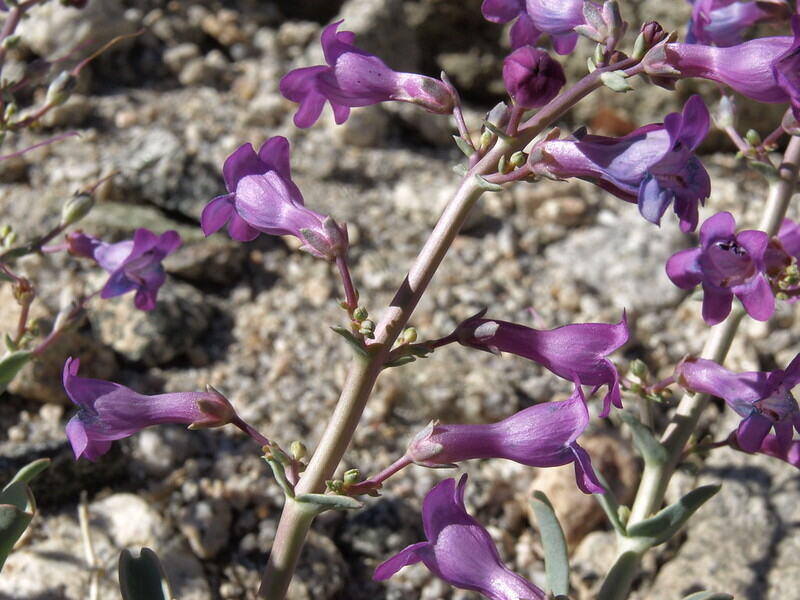
Photo Credit: Jim Morefield / Flickr / CC BY-SA 2.0
Beardtongues are a lovely family of flowers, some of which are native to Los Angeles. LA-native beardtongues range between purple, pink, and red to yellow.
One of the most popular kinds of beardtongue is showy penstemon. Showy penstemon is a stunning herb that attracts birds and various insects. Other native beardtongue kinds are the climbing penstemon, the foothill penstemon, the southern foothill penstemon, and the yellow bush penstemon.
However, beardtongues have toxic effects, so be careful to keep children and pets away from them.
Growth habit: Sub-shrub
Mature size: 6 inches to 4 feet tall depending on species
Duration: Perennial
Foliage: Some species are evergreen, while others are deciduous
Sunlight needs: Full sun
Soil preferences: Well-draining sandy or rocky soils
Maintenance needs: Water 1 inch per week in summer; cut back stems after flowering season
Potential hazards: Toxic
How to Choose the Best Los Angeles Natives for Your Landscape
There are plenty of options when it comes to choosing Los Angeles natives for your landscape. Make sure to consider your options carefully and pick plants that meet your specific needs and preferences.
Be mindful of potential hazards such as toxicity, and do your research to protect your family and pets. Some plants are more toxic than others, but to be on the safe side, you should always keep your pets from eating your garden plants.
Additionally, you need to pick plants that are suitable for your hardiness zone. Los Angeles hardiness zones range from 7a to 11a, depending on the area. This means that LAs’ lowest temperatures are between 0 and 45 degrees Fahrenheit.
All of the plants in this article can grow in all of Los Angeles’s temperatures, except where mentioned otherwise. You can check your local minimum temperature here.
Where to Find Native Plants in Los Angeles
Check your yard, and you might just find that some native plants have already made a home there. But if you want to plant new natives, never take them directly from the wild because it can disrupt local ecosystems and harm wildlife.
Instead, there are ethical sources that can help. Consider purchasing from local plant nurseries that specialize in native plants, such as:
- Mickey Hargitay Plants
- Glendora Gardens Nursery and Tree Farm
- Mezcala Nursery
- Sunset Nursery
- Ayala’s Nursery
The Final Word
Picking beautiful new plants for your yard is a fun experience. Once you’ve decided on the types of plants you want, it’s time to think about other factors that will make your lawn thrive and look its best. Make sure you get the right grass type for your area and that you take care of your lawn properly at each time of the year.
If you want your native plant garden to stay healthy and beautiful, consider hiring one of WikiLawn’s local pros who can handle your landscaping needs.
Main Image Credit: Udo Schmidt / Flickr / CC BY-SA 2.0